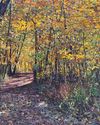
The futurist H.G. Wells wrote an article in 1914 titled “The War That Will End War,” a phrase that is now considered paradoxical. When I first went to England, the sculptures on World War I memorials struck me. The figures seemed to represent real people. And, they were young. About 250,000 of Britain’s soldiers in the war were under 18. George V was king, having succeeded his father, Edward VII, in 1910. Edward’s reign was known as the Edwardian Era, familiar to everyone who watched Downtown Abbey.
One hundred years after the fact, this country will soon have a National WWI Memorial with an extraordinary bronze relief by Sabin Howard, composed of 38 figures, each readable as an individual with a personal story within the overall depiction of A Soldier’s Journey.
The idealism of the prewar period didn’t die in the war or in succeeding wars and even some of the high fashion and style crops up from time to time. Edwardian period beards are familiar from period portraits by John Singer Sargent and in almost any town in America today.
Ben Lupkin works in his family’s stained glass studio in Fort Wayne, Indiana. He sports an Edwardian beard and moustache in a profile portrait captured by his brother, painter Peter Lupkin. Profile portraits can be found on ancient coins and were popular on medallions and in paintings of the Italian Quattrocento (1400-1499).
Ben can be distinguished from his Edwardian peers by his 21st-century baseball cap and pocket tee. He gazes at a higher light, inspired perhaps as his father was when he saw a stained-glass window of St. George and the Dragon, which later inspired him to become an artist.
This story is from the August 2020 edition of American Art Collector.
Start your 7-day Magzter GOLD free trial to access thousands of curated premium stories, and 9,000+ magazines and newspapers.
Already a subscriber ? Sign In
This story is from the August 2020 edition of American Art Collector.
Start your 7-day Magzter GOLD free trial to access thousands of curated premium stories, and 9,000+ magazines and newspapers.
Already a subscriber? Sign In

FULL EXPOSURE
Photographer Conor Martin documents the present using photographic methods of the past.

Autumnal Light
The landscapes and nature scenes of painter Jennifer Sowders are irresistibly tactile, filled with varying textures that seem to leap off the canvas.

Art for All
Members of Art Dealers Association of America come together for a philanthropic affair.

Modern Marketplace
Redwood Art Group brings together the San Diego region for another class-act celebration of contemporary artwork.

An Enchanting Evening
Scottsdale Artists’ School knows how to throw an art party.

Timeless Tales
Soft, warm undertones underscore the mood of enchantment that runs through Nom Kinnear King’s paintings.

Next Exit New York
Coming off his series that focused on San Francisco and Los Angeles freeway signs, artist Eric Nash’s sights are now set on New York. Now on view at George Billis Gallery's Manhattan location are seven of Nash's new oil paintings and two drawings that explore the signage of New York City freeways. Although Nash's work is tightly rendered, he doesn’t consider himself a photorealist, but rather someone who utilizes those techniques to express ideas.

Monster Mash
Vampires, witches, ghouls and all things that go bump in the night are the theme of the exhibition Monster Mash, now at Abend Gallery.

Inside/Outside
Those familiar with Geoffrey Johnson's populated by inky figures and trailing shadows that bleed into the wet streets, and architectural elements obscured to varying degrees by the misty atmosphere.

Bold Figures; Bold Color
For Brooklyn based painter J Louis, it’s all about balance, which can mean many different things in a composition, but for Louis, it’s about balancing his female figures among a unique landscape of color.